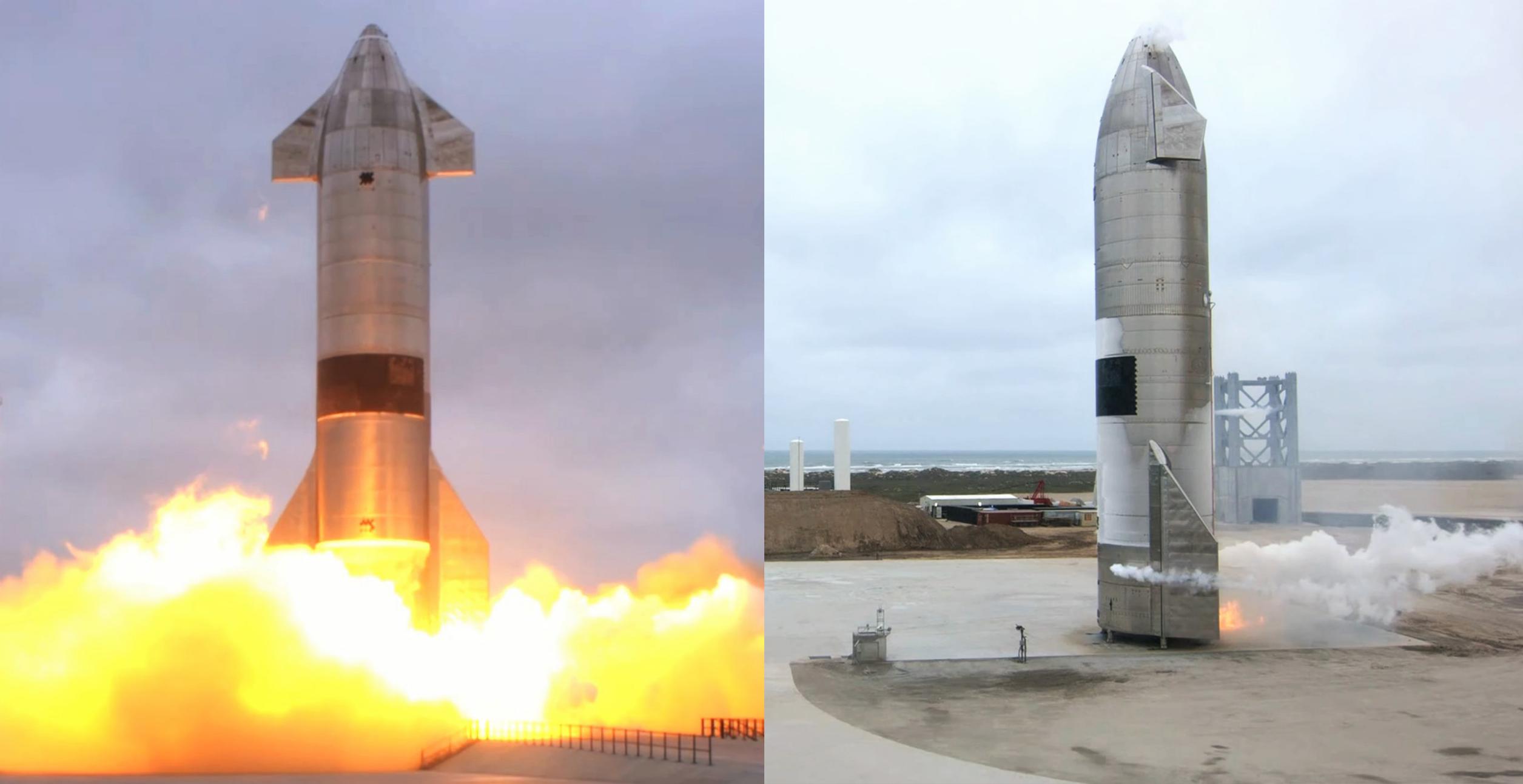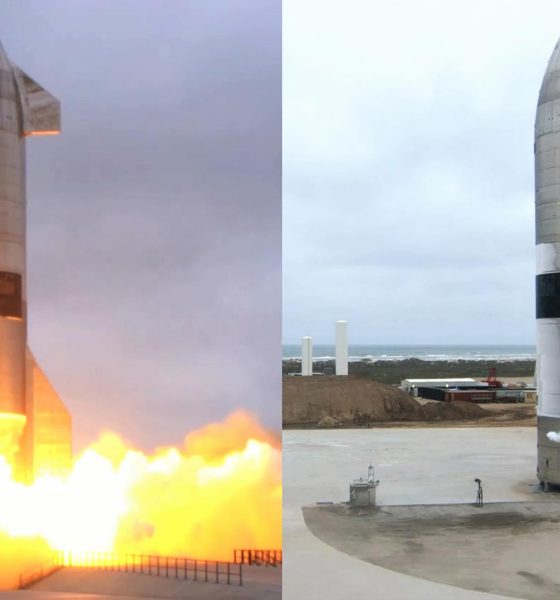

News
SpaceX nails first Starship landing weeks after NASA Moon lander contract [updated]
Update: For the first time ever, SpaceX has successfully landed a Starship prototype in one piece and kept the giant steel rocket intact throughout the post-flight safing process. The fun, however, is just beginning.
First and foremost, excluding simpler Starship prototypes SN5 and SN6, Starship SN15 is the first prototype to actually complete that safing process. In theory, safing a liquid fuel rocket is a fairly novel task given so few rockets are actually reusable. It involves detanking, purging plumbing and Raptor engines, deactivating explosive flight termination system (FTS) charges, and more generally verifying the health and status of all systems. With a rocket as complex as Starship, SpaceX is treading new ground with almost every step, meaning that even something as seemingly benign as keeping a rocket intact after a successful landing carries risk (e.g. SN10).
SN5 and SN6 also had a rough go of things even after surviving their landings and it took anywhere from 12 to 24+ hours before SpaceX declared either vehicle safe to approach. The degree to which Starship SN15’s launch and landing was a success is hinted at by the fact that SpaceX had teams approaching the rocket less than four hours after touchdown. Still, more than six hours after landing, those SpaceX teams were still working to transport a crane to the site after rolling a self-propelled modular transporter (SPMT) within the vicinity of Starship SN15.
Eventually, that crane will lift SN15 onto a custom jig installed on said SPMT and take its flimsy, unreliable legs out of the equation. At that point, the Starship prototype will well and truly be safe and secure and ready for whatever else SpaceX may have in store, be that a quiet future as a permanent display or the program’s first reuse. Stay tuned for updates as SpaceX secures the historic rocket and prepares to reopen the highway to the public.
In perhaps the best possible news that could have followed NASA’s historic SpaceX Moon lander contract, the company has successfully landed a Starship prototype in one piece – without it exploding – for the first time ever.
In spite of unusually unreliable live views from the rocket’s onboard cameras, possible due to SpaceX using Starlink as a Starship antenna for the first time, Starship serial number 15 (SN15) touched down at the very edge of the landing pad a bit less than seven minutes after lifting off from SpaceX’s Boca Chica launch facilities.
Like all four of its predecessors, Starship SN15 ignited all three of its Raptor engines and gradually ascended to an altitude of ~10 km (6.2 mi), shutting down one engine every 90 or so seconds along the way. At apogee, after briefly hovering under the power of one engine, the last Raptor cut off and Starship angled over onto its belly and simply fell back to Earth.
Using four large steel ‘flaps,’ the rocket controlled its descent like a skydiver down to approximately 500m (~2000 ft) above the ground and ignited two or three of its Raptors to aggressively flip into a tail-down orientation. SN15 then slowed all the way down under the thrust of two of those engines for an exceptionally soft – albeit inaccurate – landing on a concrete pad.
Much like SN10, which caught on fire shortly before touchdown, landed intact, and then exploded after that fire continued to burn, Starship SN15 appeared to catch fire shortly after landing and a significant fire burned for at least five minutes before disappearing. As a result, be it intentional on behalf of SpaceX or simple luck, SN15 did not explode after touchdown. The Starship also landed far more gently than Starship SN10, which effectively pancaked its tiny legs and embedded its skirt directly into concrete.
Ultimately, Starship SN15’s fully successful launch and landing is an immense achievement after four failed – but data-rich – attempts and confirms that SpaceX is on the right track. Perhaps even more importantly, the success is quite possibly the best conceivable vindication for NASA after the space agency made the shocking decision to return humanity to the Moon with SpaceX’s Starship.

Elon Musk
Elon Musk’s X will start using a Tesla-like software update strategy
The initiative seems designed to accelerate updates to the social media platform, while maintaining maximum transparency.

Elon Musk’s social media platform X will adopt a Tesla-esque approach to software updates for its algorithm.
The initiative seems designed to accelerate updates to the social media platform, while maintaining maximum transparency.
X’s updates to its updates
As per Musk in a post on X, the social media company will be making a new algorithm to determine what organic and advertising posts are recommended to users. These updates would then be repeated every four weeks.
“We will make the new 𝕏 algorithm, including all code used to determine what organic and advertising posts are recommended to users, open source in 7 days. This will be repeated every 4 weeks, with comprehensive developer notes, to help you understand what changed,” Musk wrote in his post.
The initiative somewhat mirrors Tesla’s over-the-air update model, where vehicle software is regularly refined and pushed to users with detailed release notes. This should allow users to better understand the details of X’s every update and foster a healthy feedback loop for the social media platform.
xAI and X
X, formerly Twitter, has been acquired by Elon Musk’s artificial intelligence startup, xAI last year. Since then, xAI has seen a rapid rise in valuation. Following the company’s the company’s upsized $20 billion Series E funding round, estimates now suggest that xAI is worth tens about $230 to $235 billion. That’s several times larger than Tesla when Elon Musk received his controversial 2018 CEO Performance Award.
As per xAI, the Series E funding round attracted a diverse group of investors, including Valor Equity Partners, Stepstone Group, Fidelity Management & Research Company, Qatar Investment Authority, MGX, and Baron Capital Group, among others. Strategic partners NVIDIA and Cisco Investments also continued support for building the world’s largest GPU clusters.
News
Tesla FSD Supervised wins MotorTrend’s Best Driver Assistance Award
The decision marks a notable reversal for the publication from prior years, with judges citing major real-world improvements that pushed Tesla’s latest FSD software ahead of every competing ADAS system.

Tesla’s Full Self-Driving (Supervised) system has been named the best driver-assistance technology on the market, earning top honors at the 2026 MotorTrend Best Tech Awards.
The decision marks a notable reversal for the publication from prior years, with judges citing major real-world improvements that pushed Tesla’s latest FSD software ahead of every competing ADAS system. And it wasn’t even close.
MotorTrend reverses course
MotorTrend awarded Tesla FSD (Supervised) its 2026 Best Tech Driver Assistance title after extensive testing of the latest v14 software. The publication acknowledged that it had previously criticized earlier versions of FSD for erratic behavior and near-miss incidents, ultimately favoring rivals such as GM’s Super Cruise in earlier evaluations.
According to MotorTrend, the newest iteration of FSD resolved many of those shortcomings. Testers said v14 showed far smoother behavior in complex urban scenarios, including unprotected left turns, traffic circles, emergency vehicles, and dense city streets. While the system still requires constant driver supervision, judges concluded that no other advanced driver-assistance system currently matches its breadth of capability.
Unlike rival systems that rely on combinations of cameras, radar, lidar, and mapped highways, Tesla’s FSD operates using a camera-only approach and is capable of driving on city streets, rural roads, and freeways. MotorTrend stated that pure utility, the ability to handle nearly all road types, ultimately separated FSD from competitors like Ford BlueCruise, GM Super Cruise, and BMW’s Highway Assistant.
High cost and high capability
MotorTrend also addressed FSD’s pricing, which remains significantly higher than rival systems. Tesla currently charges $8,000 for a one-time purchase or $99 per month for a subscription, compared with far lower upfront and subscription costs from other automakers. The publication noted that the premium is justified given FSD’s unmatched scope and continuous software evolution.
Safety remained a central focus of the evaluation. While testers reported collision-free operation over thousands of miles, they noted ongoing concerns around FSD’s configurable driving modes, including options that allow aggressive driving and speeds beyond posted limits. MotorTrend emphasized that, like all Level 2 systems, FSD still depends on a fully attentive human driver at all times.
Despite those caveats, the publication concluded that Tesla’s rapid software progress fundamentally reshaped the competitive landscape. For drivers seeking the most capable hands-on driver-assistance system available today, MotorTrend concluded Tesla FSD (Supervised) now stands alone at the top.
News
Elon Musk’s Grokipedia surges to 5.6M articles, almost 79% of English Wikipedia
The explosive growth marks a major milestone for the AI-powered online encyclopedia, which was launched by Elon Musk’s xAI just months ago.

Elon Musk’s Grokipedia has grown to an impressive 5,615,201 articles as of today, closing in on 79% of the English Wikipedia’s current total of 7,119,376 articles.
The explosive growth marks a major milestone for the AI-powered online encyclopedia, which was launched by Elon Musk’s xAI just months ago. Needless to say, it would only be a matter of time before Grokipedia exceeds English Wikipedia in sheer volume.
Grokipedia’s rapid growth
xAI’s vision for Grokipedia emphasizes neutrality, while Grok’s reasoning capabilities allow for fast drafting and fact-checking. When Elon Musk announced the initiative in late September 2025, he noted that Grokipedia would be an improvement to Wikipedia because it would be designed to avoid bias.
At the time, Musk noted that Grokipedia “is a necessary step towards the xAI goal of understanding the Universe.”
Grokipedia was launched in late October, and while xAI was careful to list it only as Version 0.1 at the time, the online encyclopedia immediately earned praise. Wikipedia co-founder Larry Sanger highlighted the project’s innovative approach, noting how it leverages AI to fill knowledge gaps and enable rapid updates. Netizens also observed how Grokipedia tends to present articles in a more objective manner compared to Wikipedia, which is edited by humans.
Elon Musk’s ambitious plans
With 5,615,201 total articles, Grokipedia has now grown to almost 79% of English Wikipedia’s article base. This is incredibly quick, though Grokipedia remains text-only for now. xAI, for its part, has now updated the online encyclopedia’s iteration to v0.2.
Elon Musk has shared bold ideas for Grokipedia, including sending a record of the entire knowledge base to space as part of xAI’s mission to preserve and expand human understanding. At some point, Musk stated that Grokipedia will be renamed to Encyclopedia Galactica, and it will be sent to the cosmos.
“When Grokipedia is good enough (long way to go), we will change the name to Encyclopedia Galactica. It will be an open source distillation of all knowledge, including audio, images and video. Join xAI to help build the sci-fi version of the Library of Alexandria!” Musk wrote, adding in a later post that “Copies will be etched in stone and sent to the Moon, Mars and beyond. This time, it will not be lost.”








